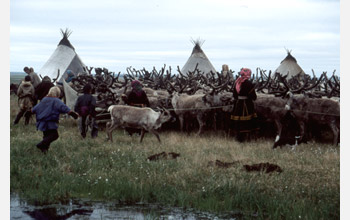Multimedia Gallery
Resilience of Siberian Nomads (Image 5)
Nenets women and children herd reindeer into a temporary corral. Once collected, draft animals can be individually identified and selecting for hauling sledges in order to move people and goods to the next camp. These nomadic, pastoral herders have been in western Siberia, Russian, for over a thousand years, but changes such as industrial development, climate change and socio-economic upheaval may threaten their lifestyle. [Image 5 of 5 related images. Back to Image 1.]
More about this Image
The Nenets have been in the area for over a thousand years, but more recently, they have faced threats to their lifestyle due to warming temperatures (average temperatures in the region have increased by 1-2 degrees Celsius over the past 30 years), socioeconomic upheaval, and the oil and gas industry, which has brought workers and infrastructure--such as roads and pipelines, and degradation to rivers and lakes. In response to these changes, the Nenet have adjusted their reindeer migration routes and timing, avoid disturbed and degraded areas, and are developing new economic practices and social interaction.
Bruce C. Forbes, professor of global change at the Arctic Centre, University of Lapland, Finland, has been studying Yamal Nenets, seeking to understand the factors that have made their way of life so resilient. Forbes uses a combination of satellite-based mapping, social anthropology and examining ground-level changes in the vegetation that reindeer feed on, to conduct his research. Industrial disturbance and heavy grazing and trampling by reindeer has changed vegetation on the tundra from shrubs to graminoid (grass) species.
Based on his research findings, Forbes believes the Nenets and their reindeer herds may be more resilient to rapid ecological changes than previously thought. However, he cautions that the continued expansion of infrastructure, as well as the terrestrial and freshwater ecosystem degradation, climate change, and the influx of workers in the area, could present a threat to the Nenets in the future.
Forbes has a background in applied ecology and geography in permafrost environments. His experience is circumpolar, having conducted field studies on human impacts on vegetation and soils, and with special emphasis on the consequences of petroleum development on the boreal forest and arctic ecosystems of Alaska, Canada, western and eastern Siberia, and Fennoscandia. Recent work emphasizes coupled social-ecological systems and resilience at various spatial and temporal scales. [This research was supported in part by National Science Foundation grant OPP 05-31200.] (Date of Image: 2005-2007)
Credit: B.C. Forbes, Arctic Centre, University of Lapland
Images and other media in the National Science Foundation Multimedia Gallery are available for use in print and electronic material by NSF employees, members of the media, university staff, teachers and the general public. All media in the gallery are intended for personal, educational and nonprofit/non-commercial use only.
Images credited to the National Science Foundation, a federal agency, are in the public domain. The images were created by employees of the United States Government as part of their official duties or prepared by contractors as "works for hire" for NSF. You may freely use NSF-credited images and, at your discretion, credit NSF with a "Courtesy: National Science Foundation" notation.
Additional information about general usage can be found in Conditions.
Also Available:
Download the high-resolution TIF version of the image. (2.1 MB)
Use your mouse to right-click (Mac users may need to Ctrl-click) the link above and choose the option that will save the file or target to your computer.



